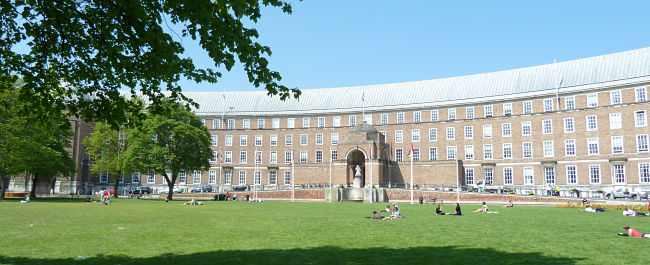Energy planning in cities requires holistic assessment of both environmental and health impacts

This research has developed a model for analysing energy related policies and their effects both in the city and beyond.
About the research
When assessing potential new ways of providing energy in cities, it is vital to consider the effects on emissions of both greenhouse gases (GHG) and air pollutants. In many cases, replacing one energy source with another may reduce GHG emissions but instead increase emissions of air pollutants, bringing with them ill-effects on health and wellbeing.
Similarly, changing a city’s energy system will often have a knock-on effect on upstream processes (e.g. the extraction of raw materials), which often affect areas outside of the city.
The European-funded project Urban Reduction of Greenhouse Gas Emissions in China and Europe (URGENCHE) aimed to effectively integrate policies relating to GHG emissions with those on health and wellbeing.
As part of this project, the team has developed a tool for analysing energy-related policies that assesses the impacts of both GHG emissions and air pollutants, and incorporates an assessment of effects on upstream processes.
The study examined energy-related policies in four case study cities: Suzhou (China), Kuopio (Finland), Stuttgart (Germany) and Basel (Switzerland). Policies assessed included: efficiency levels of electricity and heat generation in power plants; the use of wood pellets for heating; increased use of biomass; and the electric vehicles policy.
Policy implications
- All cities should make use of the URGENCHE model to analyse their energy policies. As long as the city has recorded a full year’s ‘energy balance’ (describing import and flow of energy, energy conversion and use of energy sources within a city) the model can be used to assess the potential impact of different energy policies on emissions of GHG and air pollutants.
- The use of electric vehicles can significantly reduce negative impacts both on climate and health, and should be encouraged; however, this should be accompanied by the increased use of renewable energies to generate the electricity required.
- In cities with low air exchange, biomass burning should only be allowed in conjunction with the newest technologies. For example, log wood and wood chip boilers should be equipped with a particle filter, and wood pellets should be used in place of log wood.
- In Chinese cities, large coal fired power and CHP (combined heat and power) plants should be equipped with state of the art dust and desulphurisation filters, while smaller coal fired plants should be replaced by plants using other fuels.
Key findings
Improving energy efficiency is vital, as in many cases it combines lower emissions of both GHG and air pollutants with lower costs. By determining the energy balance of a city (that is, the balance of import, flow, conversion and use of energy sources within a city), the model developed can be used to estimate the emissions of greenhouse gases and air pollutants in and outside of the city. In turn, it can be used to assess the effectiveness of an energy policy with regard of environmental control. The impacts of air pollution control can then be further assessed using an integrated assessment tool such as ECOSENSE (www.ExternE.info).
From the four case study cities:
- Basel, Switzerland: Using electric cars will reduce air pollution in cities by replacing diesel and gasoline with electricity; however, the effect on air pollution beyond the city greatly depends on the technology mix used for generating the electricity. A reduction in GHG will only be possible with an increase in the use of renewable energies (or nuclear energy where accepted) for electricity generation, in line with the increase in energy demand brought about by the use of electric vehicles.
- Kuopio, Finland: The use of biomass (wood) instead of peat was found to cause a 46% reduction of CO2 emissions at the city’s CHP (combined heat and power) plant. Emissions from air pollutants were slightly higher; however, due to the plant’s high stack (chimney) and its location outside the city, any associated health impacts were found to be negligible.
- Stuttgart, Germany: Pellet boilers help to reduce CO2 emissions by replacing fossil energy sources. However, compared to oil and gas boilers, pellet boilers cause much higher emissions of particulate matter, which lead to negative impacts on human health, especially in cities with low air exchange and low wind speeds. The research findings revealed that for the city of Stuttgart, the reduction in greenhouse gas emissions did not outweigh the associated negative health impacts. A net benefit of using wood pellets in small pellet boilers would only be achieved by fitting dust filters to the boilers.
- Suzhou, China: Electricity and heat generating plants were found to be inefficient, with emissions of fine dust, sulphur dioxide and nitrogen oxides very high compared to the best available technologies. To reduce emissions and GHG efficiently, large coal fired power and CHP (combined heat and power) plants should be equipped with state of the art dust filters (electrostatic precipitators) and wet ‘scrubbers’ (desulphurisation plants), while smaller coal fired plants should be closed and replaced by plants for other fuels (e.g. natural gas).
Further information
Visit the project website: www.urgenche.eu
This project was supported by the 7th European Framework Program: Grant Agreement No. 265114
Policy Briefing 15: 2015
Energy planning in cities requires holistic assessment (PDF, 151kB)
Contact the researchers
Professor Rainer Friedrich, IER University of Stuttgart, Germany:
rf@ier.uni-stuttgart.de
Professor Clive Sabel, University of Bristol, UK:
c.sabel@bristol.ac.uk
Authors
Professor R. Friedrich, IER University of Stuttgart, Professor C. Sabel, University of Bristol, Dr S Torras Ortiz, IER University of Stuttgart, Professor J. Toumisto, National Institute for Health and Welfare (THL, Finland)

